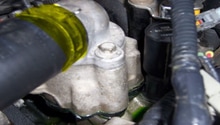Ford Mustang GT 1996-2014: How to Stop Coolant Leak
While replacing leaky cooling system components is the best solution, various stop leak products are available to help cure everything from a small pinhole leak to a blown head gasket.
This article applies to the Ford Mustang GT (1996-2014).
If you own a car long enough, you are bound to have a coolant leak sooner or later. Over time and mileage, various cooling system components can vibrate, loosen, and lead to leaks. Similarly, rubber cooling hoses tend to break down and become brittle, thus allowing coolant leaks. Further, neglected cooling system maintenance can allow the cooling system to corrode from the inside-out and cause a host of cooling system issues. While proper replacement of a leaking component is preferred, you may find yourself in a situation where a stop leak product is necessary to keep your car functioning. Fortunately, there are a number of stop leak products available that can quickly and easily be placed in the cooling system to stop leaks, allowing for worry-free vehicle operation. This article will provide information on how to stop a coolant leak for the 1996 to 2004 Ford Mustang GT.

Materials Needed
- Catch pan
- Funnel
- Pliers or hose clamp tool
- U.V. dye or cooling system pressure tester (optional)
- Stop leak product
- Floor jack and jack stands (optional)
- Raw eggs and cigarette tobacco, ground ginger or black pepper (optional)
When a leak in the cooling system has developed, it is generally recommended that the leaky component be replaced entirely to ensure proper cooling system operation. On the other hand, certain leaks can be difficult to access or are not cost-effective to repair, so a cooling system stop leak product can be used to fix the leak.
Step 1 – Locate source of leak
Perhaps the most important step in fixing any kind of leak is to properly identify where the leak is coming from. Although most leaks can be plugged with a stop leak product, it is sometimes unnecessary. In many cases, items like a loose hose clamp, split radiator hose, or cracked coolant reservoir can be quickly and easily repaired, eliminating the need for any cooling system additives. Most external coolant leaks can usually be spotted by simply taking a quick look around the engine bay. Additionally, a handheld cooling system pressure tester or cooling system dye additive and black light can be used to aid in identifying the leaky area. An internal engine coolant leak, such as a blown head gasket, cannot typically be seen from the outside of the engine. Inspecting the engine oil for signs of coolant contamination, or examining the spark plugs and exhaust are a few straightforward ways to identify an internal coolant leak. After properly determining the source of the coolant leak, you can proceed with the necessary corrective action.
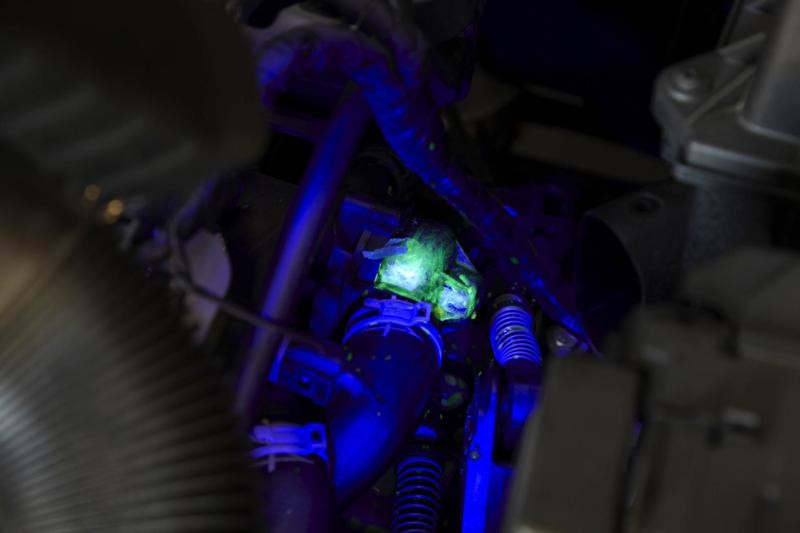
Pro Tip
Most modern radiators consist of an aluminum core mated to plastic end-tanks and are known to leak after several years of service. The radiators usually begin to leak along the seams where the core and end-tanks are clamped together.
Step 2 – Choose "stop leak" product
If you have located your coolant leak and have decided to use a stop leak product, several options are available
Temporary Fix
Many individuals only want to use a stop leak product as a last resort in order to get their car back home or to the local garage for repairs. Instead of using a permanent sealer that will remain in the cooling system for the life of the vehicle, several home-brew remedies can be used to stop a coolant leak for a period of time. Items such as raw eggs, cigarette tobacco, ground ginger, and black pepper can be introduced into the cooling system for leak repair, but are also able to be flushed out at a later time when the leaking component has been fixed or replaced. The idea is that these small particles will circulate in the cooling system and accumulate at the source of the leak. The pressure of the cooling system will help to pack these small particles into the hole, crack, or crevice and seal off the leak. These items have been used for years in emergency situations by do-it-yourselfers and shade tree mechanics alike. Similarly, cold weld products, such as JB-Weld, have been used to temporarily fill cracks or splits in radiator end-tanks, coolant reservoirs, and freeze plugs. While a cold weld is quite strong, heat and pressures from the cooling system will eventually cause the weld to fail, hence it being a temporary fix.
Permanent Fix
Many commercially available stop leak products on the market allow for a permanent solution to fixing a cooling system leak. These permanent solutions can be a last resort for individuals who are facing huge repair bills for something like a blown head gasket or cracked cylinder. Products like Bar's Leak use a "liquid metal" formula that circulates the cooling system before hardening at the source of the leak. These formulas bond to the leaking surface from the inside out, and when cured, become extremely durable. Similarly, there are "bead-type" stop leak products, such as Justice Bros Stop-Leak, that use gritty sand-like nodules to fill leaking voids. While these products do a good job of sealing up leaks in the cooling system, they can sometimes do too good of a job and limit coolant flow to certain areas of the engine. These commercial products should be used sparingly. It is worth noting that remnants of these stop leak products will remain in the cooling system for the life of the vehicle.

Pro Tip
Stop leak products will fix many different types of coolant leaks; however, severely damaged or failed cooling system components should be replaced. For example, no amount of stop leak will fix a radiator that has suffered impact damage from roadside debris.
Step 3 – Add stop leak to cooling system
The Mustang uses a pressurized cooling system with a coolant reservoir (a.k.a. coolant expansion tank). For this type of system, a small amount of coolant must be drained and the stop leak product of your choice added through the top radiator hose.
- If your commercially available stop leak product requires a cooling system flush before using, refer to How to Flush Radiator before proceeding.
- With the engine cool, partially drain the cooling system via the radiator drain cock located on the lower portion of the radiator. Have a clean catch pan handy to catch the draining coolant, as the coolant will be reused.
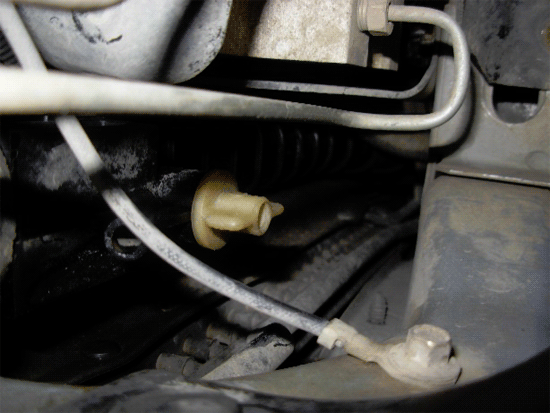
- After draining a few liters of coolant, remove one end of the upper coolant hose from either the radiator or engine.
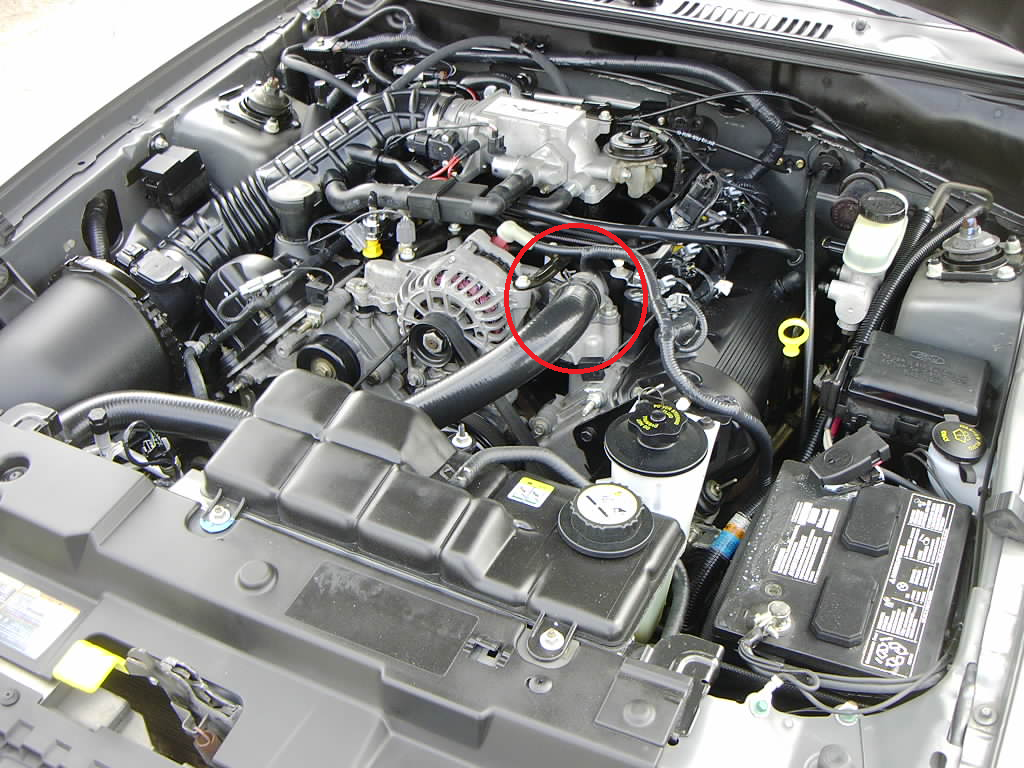
- With one end of the hose removed, pour the stop leak product into the hose. The amount of stop leak needed will vary depending on which product your are using. Follow the manufacturer's instructions and fill as necessary.

- If using a temporary fix, crack two to four eggs and place the egg whites into the radiator hose. Two to three tablespoons are recommended if using ginger, pepper, or tobacco.
- Reattach the coolant hose and top off the cooling system with the coolant that was drained earlier.
- Start the engine to allow the stop leak to circulate the cooling system. Be sure to turn the heater on, as well.
- If using a commercial stop leak product, follow the manufacturer's instruction on how long to let the engine run. If using a temporary fix, allow the engine to reach full operating temperature by running approximately 10 to 15 minutes.
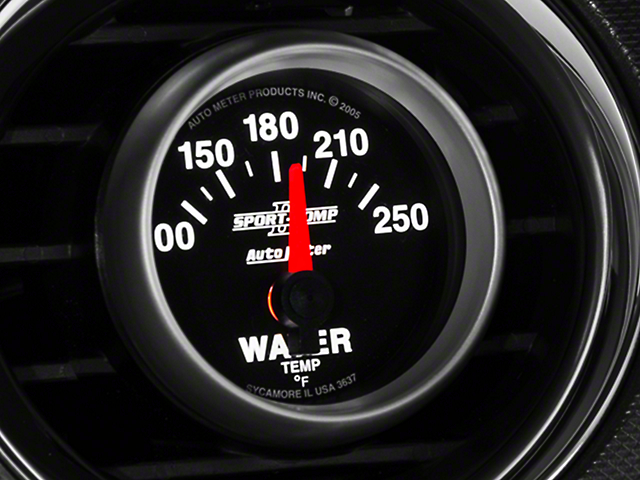
- After the engine has run the recommended amount of time, inspect the area that was previously leaking coolant. If the area is dry, you are finished and the car is ready to drive. If the leak is still present, repeat Step 3. If the problem persists, consider replacing the leaking component.
- If you are attempting to fix an internal engine leak, proceed with driving the car but continue to regularly monitor the coolant temperature and coolant level. If coolant continues to mysteriously disappear, chances are the stop leak was unsuccessful.
Related Discussions
- Bar's Leak Radiator Stop Leak Vote Now - MustangForums.com
- Bars Stop Leak - MustangForums.com

